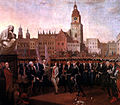mNo edit summary |
caption - by Peszke |
||
| Line 1: | Line 1: | ||
[[Image:Franciszek Smuglewicz.jpg|thumb|250px|right|Franciszek Smuglewicz]] |
[[Image:Franciszek Smuglewicz.jpg|thumb|250px|right|Franciszek Smuglewicz by [[Józef Peszke]], his student.]] |
||
'''Franciszek Smuglewicz''' ([[1745]]-[[1807]]) was a [[Poland|Polish]] draughtsman and painter. Brother of [[Antoni Smuglewicz|Antoni]], he is considered the first Polish historical painter and, to certain extent, a spiritual father of [[Jan Matejko]]'s school. |
'''Franciszek Smuglewicz''' ([[1745]]-[[1807]]) was a [[Poland|Polish]] draughtsman and painter. Brother of [[Antoni Smuglewicz|Antoni]], he is considered the first Polish historical painter and, to certain extent, a spiritual father of [[Jan Matejko]]'s school. |
||
Revision as of 23:40, 14 April 2006

Franciszek Smuglewicz (1745-1807) was a Polish draughtsman and painter. Brother of Antoni, he is considered the first Polish historical painter and, to certain extent, a spiritual father of Jan Matejko's school.
Smuglewicz was born October 6, 1745 in Warsaw, Poland. In 1763 he moved to Rome, where he started studies of fine arts under tutorship of Antonio Maroni. In 1765 he received a royal scholarship of king Stanisław August Poniatowski and was admitted to the Saint Lucas Academy. In 1784 he returned to his native Warsaw, where he founded his own school of fine arts, one of the predecessors of the modern Academy of Fine Arts.
A classicist, but under strong influence of the Polish baroque, Smuglewicz became the first Polish representative of historical painting, a notion that dominated the fine arts of Poland throughout the 19th century. Around 1790 he started working on a series of sketches and lithographies inspired by Adam Naruszewicz's History of the Polish Nation. Although never finished, the seried gained him much popularity.
In 1797 he moved to Wilno (modern Vilnius, Lithuania), where he became the founder and the first deacon of the Institute of Sketch and Painting at the Academy of Wilno. A tutor of several generations of Polish-Lithuanian painters, Smuglewicz devoted himself to historical painting in the latter years of his life. Among the notable surviving works of that period are A Meeting of the Four Years' Sejm (1793) and Kościuszko's Oath at Kraków's Old Town Market (1797). He also painted a series of depictions of contemporary views of the city. Among his works of the period are priceless views of the city walls and city gates, demolished in 19th century.
He died September 18, 1807 and was buried at the Rossa Cemetery, although his grave remains unknown.
-
Portrait of the Prozor Family, 1789, National Museum in Warsaw
-
"Tadeusz Kościuszko taking the oath", 1797
Trivia
Because he lived the latter part of his life in a city that became predominantly Lithuanian after 1945, he is often considered to be Lithuanian and his name is rendered Pranciškus Smuglevičius.

